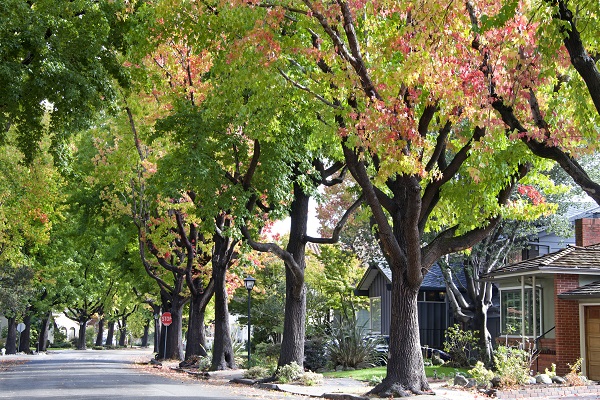Trees & Water
How often do you think about where stormwater goes after it hits the pavement and runs into the storm drain?
It can come as a surprise when you realize how much pollution—sediment, excess nutrients, viruses, bacteria and more—all of the runoff carries to our lakes, reservoirs, streams, and rivers. This pollution comes at a cost, not only in how much money is spent to make water drinkable but also in the health risks it poses to water recreation.
Trees offer a simple and beautiful way to intercept some of that runoff, and they provide a lot of other benefits, too. So, how do trees affect stormwater?
Most of the rainfall that trees capture is consumed through the processes of transpiration and evapotranspiration. Transpiration occurs when a tree pulls water from the soil and releases it as a vapor during photosynthesis. Evapotranspiration occurs when water intercepted by a tree’s limbs and leaves is evaporated into the air as a vapor. Trees also reduce throughfall, which means rainfall volume and velocity are reduced. Less runoff moving more slowly translates into less soil erosion. Finally, tree roots and root decomposition increases the capacity for soil to soak up rain water. This reduces how much stormwater runs off. The image below illustrates how water cycles through a tree.

Let’s consider how much water we’re talking about: the runoff from one acre of paved parking generates the same amount of annual runoff as 36 acres of forest. Put another way, one inch of rainfall on a one acre parking lot results in 27,000 gallons of stormwater. (Water Quality Information Center, USDA, 2008)
Compare that to a single mature oak tree, which can consume over 40,000 gallons of water in a year. A study performed by the United States Forest Service found that even a small, 9-year-old Callery pear tree intercepted 67% of the stormwater from a ½ inch rain event. In fact, it is estimated that as much as 65% of stormwater runoff can be managed by strategies within residential developments. (Dr. James R. Fazio, 2010). Trees are a big part of the strategy:
- Leaves and bark hold onto a great deal of stormwater, slowly releasing it into the air through evaporation or allowing it to descend to the ground and into the tree’s root zone. One study showed that a 40-yr Japanese zelkova tree can intercept 85% of rainfall in an average storm(Xiao, 2016).
- The mulch and/or groundcover around trees also capture stormwater, and tree roots create countless channels which help infiltrate—or soak up—the water. This is an especially important job. Before the landscape was developed into neighborhoods, roads, shops, parking lots, etc., about 50% of stormwater was infiltrated into the ground. That’s the water that fills the aquifers that feed our wells. Today, as little as 15% of stormwater soaks into the ground. That means more water is running off into our waterways, causing floods, erosion, and increased pollution. It also impacts how much water is available to our wells.
The message is clear: more trees, leaves, and roots equals less runoff (and more well water)! Trees can have a big impact on how clean our waterways are, making it possible for us to drink and play in the water without worry.
